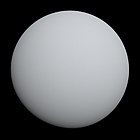HD 191089
| HD 191089 | ||
|---|---|---|
| 星座 | やぎ座 | |
| 見かけの等級 (mv) | 7.18[1] | |
| 位置 元期:J2000.0 | ||
| 赤経 (RA, α) | 20h 09m 05.2156358688s[2] | |
| 赤緯 (Dec, δ) | −26° 13′ 26.520165768″[2] | |
| 視線速度 (Rv) | -5.39 km/s[2] | |
| 固有運動 (μ) | 赤経: 40.336 ミリ秒/年[2] 赤緯: -67.417 ミリ秒/年[2] | |
| 年周視差 (π) | 19.9573 ± 0.0214ミリ秒[2] (誤差0.1%) | |
| 距離 | 163.4 ± 0.2 光年[注 1] (50.11 ± 0.05 パーセク[注 1]) | |
| 絶対等級 (MV) | 3.7[注 2] | |
HD 191089の位置(丸印)
| ||
| 物理的性質 | ||
| 半径 | 1.4 R☉[3] | |
| 質量 | 1.36 M☉[4] | |
| 表面重力 (log g) | 4.42 cgs[5] | |
| 自転速度 | 45 km/s[6] | |
| スペクトル分類 | F5 V[1] | |
| 光度 | 2.74 ± 0.02 L☉[4] | |
| 有効温度 (Teff) | 6,460 ± 30 K[4] | |
| 色指数 (B-V) | 0.480[1] | |
| 色指数 (V-I) | 0.55[1] | |
| 金属量[Fe/H] | -0.15[6] | |
| 年齢 | 2.2 ± 0.6 ×107 年[7] | |
| 他のカタログでの名称 | ||
| CD-26 14819, HIP 99273, SAO 188955[2] | ||
| ■Template (■ノート ■解説) ■Project | ||
HD 191089は、やぎ座の恒星である。年周視差の測定に基づいて計算した太陽からの距離は、約163光年であり、見かけの等級は7.18である[2][1]。周囲には、太陽系のカイパーベルトに似た残骸円盤があって、直接撮像されており、その外には淡くハロが広がっている[8]。
特徴[編集]
| 太陽 | HD 191089 |
|---|---|

|

|
HD 191089はF型主系列星で、スペクトル型はF5 Vと分類されている[1]。質量と半径は、太陽の1.4倍程度と推定され、表面の有効温度はおよそ6,460 K、光度は太陽の2.7倍と見積もられている[4][3]。
年齢は推定が難しく、等年齢線による分析では2.5億年や1.6億年という結果が出ている一方、X線強度やリチウム組成ではもっとずっと若いことが示唆される[6][5][9]。固有運動を分析した結果、HD 191089はがか座β運動星団の一員であることが確実視され、年齢も運動星団と同程度で、およそ2200万年と考えられるようになった[9][10][7]。
星周円盤[編集]

HD 191089は、赤外線天文衛星IRASの観測結果に赤外超過がみられることから、残骸円盤を持つ天体候補とされていた[12]。そして、2009年にジェミニ南望遠鏡で行われた、中間赤外線での撮像観測から、HD 191089を取り巻く円盤の姿が直接検出された[13]。さらに、画像処理技術の向上に伴い、2007年にハッブル宇宙望遠鏡のNICMOSで観測されていたHD 191089の画像に、近赤外線を散乱する円盤の姿も写っていたことが明らかとなった[14]。多くの残骸円盤で、スペクトルエネルギー分布から塵による黒体放射を仮定して得られた円盤の大きさと、直接撮像された円盤の大きさが食い違い、それはHD 191089でも同様だが、撮像では、中間赤外線での熱放射と近赤外線での散乱光という異なる原理、波長で得られた円盤像は概ね一致し、中心星から26 auないし78 auの範囲に広がっており、26 auより内側に放射はほとんどない[8]。それは、ALMA望遠鏡のミリ波による観測でも同様であった[4]。円盤内の塵の質量は、地球質量の6パーセント程度とみられる[15]。
一方、塵円盤の更に外側、中心星からはおよそ640 auくらいまでの範囲に広がるハロが存在することもわかった[8]。ハロは、内側の円盤よりも色が青く、円盤から、より粒子径の小さい塵が供給されている、という筋書でうまく説明できるとされる[8]。
| 名称 (恒星に近い順) |
質量 | 軌道長半径 (天文単位) |
公転周期 (日) |
軌道離心率 | 軌道傾斜角 | 半径 |
|---|---|---|---|---|---|---|
| 環 | 26 ± 4—78 ± 14 au | 59+4 −2° |
— | |||
| ハロ | 640 ± 130 au | 59° | — | |||
脚注[編集]
注釈[編集]
出典[編集]
- ^ a b c d e f ESA (1997), The HIPPARCOS and TYCHO catalogues. Astrometric and photometric star catalogues derived from the ESA HIPPARCOS Space Astrometry Mission, ESA SP Series, 1200, Noordwijk, Netherlands: ESA Publications Division, Bibcode: 1997ESASP1200.....E, ISBN 9290923997
- ^ a b c d e f g h “HD 191089 -- Spectroscopic Binary Candidate”. SIMBAD. CDS. 2023年9月14日閲覧。
- ^ a b Chandler, Colin Orion; McDonald, Iain; Kane, Stephen R. (2016-03), “The Catalog of Earth-Like Exoplanet Survey Targets (CELESTA): A Database of Habitable Zones Around Nearby Stars”, Astronomical Journal 151 (3), Bibcode: 2016AJ....151...59C, doi:10.3847/0004-6256/151/3/59
- ^ a b c d e Pawellek, Nicole; et al. (2021-04), “A ∼75 per cent occurrence rate of debris discs around F stars in the β Pic moving group”, Monthly Notices of the Royal Astronomical Society 502 (4): 5390-5416, arXiv:2101.12049, Bibcode: 2021MNRAS.502.5390P, doi:10.1093/mnras/stab269
- ^ a b Chen, C. H.; et al. (2006-09), “Spitzer IRS Spectroscopy of IRAS-discovered Debris Disks”, Astrophysical Journal Supplement Series 166 (1): 351-377, Bibcode: 2006ApJS..166..351C, doi:10.1086/505751
- ^ a b c Nordström, B.; et al. (2004-05), “The Geneva-Copenhagen survey of the Solar neighbourhood. Ages, metallicities, and kinematic properties of ∼14 000 F and G dwarfs”, Astronomy & Astrophysics 418: 989-1019, Bibcode: 2004A&A...418..989N, doi:10.1051/0004-6361:20035959
- ^ a b Shkolnik, Evgenya L.; et al. (2017-08), “All-sky Co-moving Recovery Of Nearby Young Members (ACRONYM). II. The β Pictoris Moving Group”, Astronomical Journal 154 (2): 69, Bibcode: 2017AJ....154...69S, doi:10.3847/1538-3881/aa77fa
- ^ a b c d e Ren, Bin; et al. (2019-09), “An Exo-Kuiper Belt with an Extended Halo around HD 191089 in Scattered Light”, Astrophysical Journal 882 (1): 64, Bibcode: 2019ApJ...882...64R, doi:10.3847/1538-4357/ab3403
- ^ a b Moór, A.; et al. (2006-06), “Nearby Debris Disk Systems with High Fractional Luminosity Reconsidered”, Astrophysical Journal 644 (1): 525-542, Bibcode: 2006ApJ...644..525M, doi:10.1086/503381
- ^ Lépine, Sébastien; Simon, Michal (2009-03), “Nearby Young Stars Selected by Proper Motion. I. Four New Members of the β Pictoris Moving Group From The Tycho-2 Catalog”, Astronomical Journal 137 (3): 3632-3645, Bibcode: 2009AJ....137.3632L, doi:10.1088/0004-6256/137/3/3632
- ^ “Astronomical Forensics Uncover Planetary Disks in Hubble Archive”. Hubble Space Telescope. STScI (2014年4月24日). 2023年9月14日閲覧。
- ^ Mannings, Vincent; Barlow, Michael J. (1998-04), “Candidate Main-Sequence Stars with Debris Disks: A New Sample of Vega-like Sources”, Astrophysical Journal 497 (1): 330-341, Bibcode: 1998ApJ...497..330M, doi:10.1086/305432
- ^ Churcher, Laura; Wyatt, Mark; Smith, Rachel (2011-01), “Resolved imaging of the HD 191089 debris disc”, Monthly Notices of the Royal Astronomical Society 410 (1): 2-12, Bibcode: 2011MNRAS.410....2C, doi:10.1111/j.1365-2966.2010.17422.x
- ^ Soummer, Rémi; et al. (2014-05), “Five Debris Disks Newly Revealed in Scattered Light from the Hubble Space Telescope NICMOS Archive”, Astrophysical Journal Letters 786 (2): L23, Bibcode: 2014ApJ...786L..23S, doi:10.1088/2041-8205/786/2/L23
- ^ Kral, Quentin; et al. (2020-09), “Survey of planetesimal belts with ALMA: gas detected around the Sun-like star HD 129590”, Monthly Notices of the Royal Astronomical Society 497 (3): 2811-2830, arXiv:2005.05841, Bibcode: 2020MNRAS.497.2811K, doi:10.1093/mnras/staa2038
関連項目[編集]
外部リンク[編集]
- Hall, Shannon (2014-05-02), Hidden Treasures in Hubble Images, Sky & Telescope
- “HD 191089”. Catalog of Circumstellar Disks (2021年8月13日). 2023年9月14日閲覧。
- “ALICE - 10527-HD-191089-F110W”. Barbara A. Mikulski Archive for Space Telescopes. STScI. 2023年9月14日閲覧。

